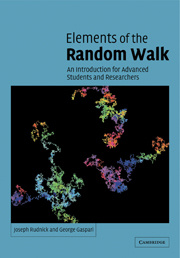Description
Elements of the Random Walk
An introduction for Advanced Students and Researchers
Authors: Rudnick Joseph, Gaspari George
A self-contained introduction to the applications of random walk techniques.
Language: English
Subject for Elements of the Random Walk:
Approximative price 57.55 €
In Print (Delivery period: 14 days).
Add to cart
Elements of the Random Walk
Publication date: 03-2010
348 p. · 17x24.4 cm · Paperback
Publication date: 03-2010
348 p. · 17x24.4 cm · Paperback
Approximative price 93.25 €
Subject to availability at the publisher.
Add to cart
Elements of the random walk : An introduction for advanced students & researchers
Publication date: 03-2004
346 p. · 17x24.4 cm · Hardback
Publication date: 03-2004
346 p. · 17x24.4 cm · Hardback
Description
/li>Contents
/li>
Random walks have proven to be a useful model in understanding processes across a wide spectrum of scientific disciplines. Elements of the Random Walk is an introduction to some of the most powerful and general techniques used in the application of these ideas. The mathematical construct that runs through the analysis of the topics covered in this book, unifying the mathematical treatment, is the generating function. Although the reader is introduced to analytical tools, such as path-integrals and field-theoretical formalism, the book is self-contained in that basic concepts are developed and relevant fundamental findings fully discussed. Mathematical background is provided in supplements at the end of each chapter, when appropriate. This text will appeal to graduate students across science, engineering and mathematics who need to understand the applications of random walk techniques, as well as to established researchers.
Preface; 1. Introduction to techniques; 2. Generating functions I; 3. Generating functions II: recurrence, sites visited, and the role of dimensionality; 4. Boundary conditions, steady state, and the electrostatic analogy; 5. Variations on the random walk; 6. The shape of a random walk; 7. Path integrals and self-avoidance; 8. Properties of the random walk: introduction to scaling; 9. Scaling of walks and critical phenomena; 10. Walks and the O(n) model: mean field theory and spin waves; 11. Scaling, fractals, and renormalization; 12. More on the renormalization group; References; Index.
© 2024 LAVOISIER S.A.S.



